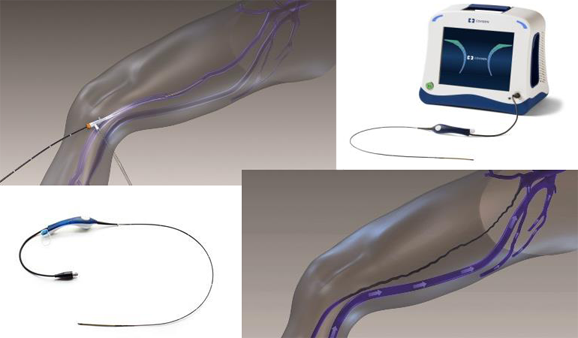At the end of the procedure, a small, clear adhesive dressings is applied to the skin over the nick (usually on the inside of the knee), and a compression stocking applied to the whole leg. If phlebectomies are performed, steristrips and more clear adhesive dressings will be applied to the skin, and sometimes an additional compression wrap over the stocking.
You will be asked to walk for 20 minutes following the procedure before returning home. This clears the deep veins of any residual sclerosant, minimizing the risk of deep vein thrombosis (DVT).
It is important to walk regularly in the days following the procedure. Avoid standing still for prolonged periods. When not mobilising, you can rest with your legs up. The majority of patients can resume regular activities the next day, but should hold off on any heavy leg exercises (e.g. running, cycling, gym exercise classes) for at least 7 days. If your work involves prolonged periods of standing or significant physical activity, it may be advised to take a short period of time off work. For guidance, please discuss your circumstances with Mr Milne.
Note: If a groin crease or knee crease incision was performed during your treatment (~2% of patients), your recovery will be a little slower. It is still important to walk regularly in the days following the procedure, but you should plan for a few quiet days and take 72 hours off work following the procedure. After 2 weeks, you will be able to gradually re-introduced leg exercises, working back up to full exercise capacity by 3 - 4 weeks.
A follow up ultrasound will be organised within 7 days following treatment to check the ablated vein and ensure there is no DVT.
The compression stocking should be worn full-time for the first 48 hours. After this, it can be taken down for showering, but otherwise it is ideal to wear for the first week. If it is uncomfortable to sleep in, it can be removed at night when in bed. After the first week, the stocking can be worn for an additional week during the day for comfort if desired.
When showering, it is best to keep the water luke-warm during the first few days. On day 5 after the procedure, the small, clear adhesive dressings (in addition to any steri-strips if used) can be peeled off in the shower.
If you are planning travel soon after your procedure, please discuss this with Mr Milne. As a rule of thumb, it is best not to travel for the first week following the procedure. After that, it is ideal to avoid plane/train/car travel over 4 hours duration until 4 weeks following the procedure. Travel of less than 4 hours duration can be undertaken after 1 week. When travelling within the first 6 weeks of the procedure, it is important to wear your compression stockings, stay hydrated, and walk around the cabin regularly whenever flying.
For general queries after the procedure, please contact the office and we will be happy to answer any questions.
Radiofrequency ablation effectively shuts down the main defective vein in >99.5% of cases. Sclerotherapy is less definitive, as the varicose veins which stem from the ablated vein are numerous. It is common to see some residual varices which require some additional injections in the post-operative period to complete the treatment. This is termed 'top-up' ultrasound-guided sclerotherapy (see ultrasound-guided sclerotherapy). Top-up ultrasound-guided sclerotherapy is usually arranged 3 - 6 months after the main treatment with radiofrequency ablation.
Please Note:
- Occasionally, a discomfort is felt along the length of the ablated vein. It is often described as a 'pulling' sensation. This usually somewhere between days 5 - 14, and is associated with inflammation of the treated vein. The discomfort settles on its own. To help it settle, it is recommended that you apply voltaren gel, wear your compression stocking, and take regular paracetamol.
- It is expected that the varicose veins become hard and lumpy under the skin following sclerotherapy. This is a good sign, as it indicates that the veins have blocked following treatment. The lumpy veins can be tender to push on for several weeks. This is another good sign, as it is associated with the inflammation that occurs in a successfully treated vein. It is rare to need anything more than paracetamoll for this. In addition, topical Voltaren gel can be used to help things settle. You will notice the lumps gradually shrink down and disappear over the months following the procedure.
- If you experience any major leg pain or swelling, or any chest pain or shortness of breath, this should be investigated urgently. If it is after-hours, Mr Milne can be contacted via the paging service.


